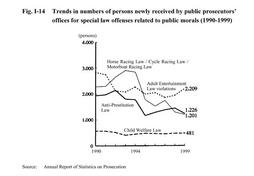| Previous Next Index Image Index Year Selection | |
|
|
3 Public morals Fig. I-14 shows trends in the number of persons newly received by public prosecutors'offices for special law offenses related to public morals over the last ten years.
The number for Adult Entertainment Law violations, has been in a generally decreasing trend in recent years. In 1999, however, it increased from the previous year to 2,209. As for Anti-Prostitution Law violations, the number had been in an increasing trend since 1996, but fell from the previous year's figure to 1,226 in 1999. The number for Child Welfare Law violations bottomed out at 406 in 1993, and since then it has been on a par at around 450. The number for Horseracing Law, Cycle Racing Law, and Motorboat Racing Law violations has been in a declining trend since 1994, with the exception of 1997. In 1999 the number was 1,201. According to Criminal Statistics by the National Police Agency, viewing the number of persons cleared for special law offenses related to public morals in 1999 by the nature of the violation, the most common Anti-Prostitution Law related violations were soliciting or similar, followed by enticement or similar, provision of locale, and contracting for prostitution, in that order. Coercion of minors into sexual acts accounted for the majority of Child Welfare Law violations. Meanwhile, the Law for the Punishment of Acts of Child Prostitution, Child Pornography, etc. , and the Protection of Children(Law No.52 of 1999) was enacted in May 1999, coming into force from November of the same year. As well as stipulating penalties for acts of child prostitution or distributing child pornography, this Law also includes provisions for measures designed to protect children who have been physically and mentally affected as a result of such acts. The number of persons newly received by public prosecutors'offices for violations of this Law in 1999 was 45 (according to the Annual Report of Statistics on Prosecution). Fig. I-14 Trends in numbers of persons newly received by public prosecutors'offices for special law offenses related to public morals (1990-1999) |
